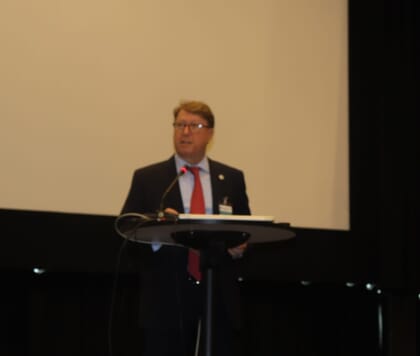Matthias Halwart, secretary of the aquaculture and fisheries branch of the FAO, launched the meeting by outlining how the event, since being launched in 2002, has evolved to become “the main intergovernmental forum to discuss global aquaculture issues”.

At the meeting, which attracted more than 140 delegates from 70 countries, he commented on the “spectacular growth” of aquaculture over the last few decades and pointed out that there are now more than 550 aquatic species cultured globally, amounting to nearly 112 tonnes, up 3.5 percent year-on-year, reaching a value of $250 billion. He also noted that aquaculture outstrips wild-harvests of all major species groups – accounting for 97 percent of seaweeds, 81 percent of freshwater fish, 55 percent of crustaceans, 73 percent of molluscs – other than marine finfish, of which only 4.5 percent are currently from farmed sources.
Global challenges facing aquaculture
“A few weeks ago The State of Food Security and Nutrition in the World was released and it confirmed that hunger and malnutrition is on the rise again. Although the prevalence of undernourishment has stabilised, the absolute number of people suffering from hunger continues to increase – one out of nine people are undernourished and nearly 151 million children under five are suffering from stunting," Halwart pointed out.
As result, he reflected, its crucial for agencies such as the FAO to act now – particularly in the fields of fisheries and aquaculture “as fish provide so many benefits in the fight against hunger and malnutrition.”
As far as key challenges the sector faces in coping with climate change, he noted that aquaculture must endevour not to pose a risk to aquatic biodiversity – pointing out that there are over 30,000 species of finfish, 52,000 species of molluscs and 64,000 species of crustaceans and "over 1,300 marine species and over 30 percent of freshwater fish are in danger.”

Moreover, Halwart noted the growing competition for both land and water, which is also going to impact the development of aquaculture.
“This is going to significantly effect our production practices as we need to adopt a more efficient use of resources, to build on synergies as well as reduce waste and reduce losses,” Halwart explained.
In order to address these challenges FAO is, according to Halwart, looking into projects in areas such as agro-ecology, nutrition sensitive and integrated aquaculture, disease prevention and management, waste reduction and recycling.
“As capture fisheries reach the limit of their biological productivity, aquaculture will continue to play an important role in meeting the needs for fish and fish products for an ever-increasing human population,” he said.
As a result, Halwart noted, FAO are currently drafting sustainable aquaculture guidelines to help governments and policy makers implement more sustainable aquaculture practices.


